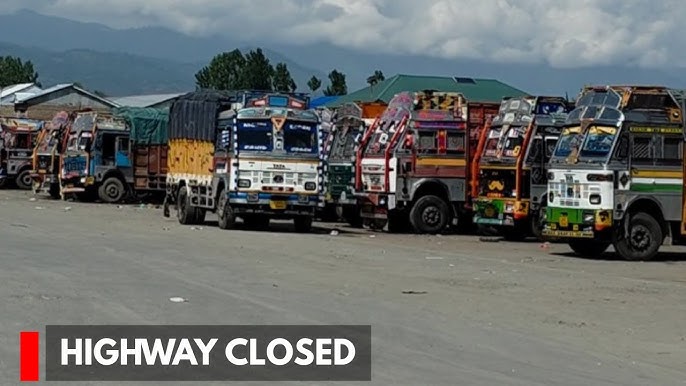A Lifeline Blocked, A Valley Strangled
By: Javid Amin | 07 September 2025
The Jammu–Srinagar National Highway (NH-44) is more than just a road. It is the umbilical cord of Kashmir’s economy, connecting the Valley to the rest of India and sustaining daily life with supplies of food, fuel, medicine, and trade goods.
But when this artery closes, as it has now for 13 consecutive days due to landslides and torrential rains, Kashmir feels suffocated—an island adrift without its lifeline.
From skyrocketing vegetable prices to halted businesses, stranded trucks, and panic among citizens, the story of this highway closure is not just about weather—it’s about the fragility of an entire region’s survival strategy.
Highway Closure: More Than Just a Traffic Jam
For most regions, a blocked highway means delays. For Kashmir, it means economic paralysis.
-
Only all-weather road link: NH-44 is Kashmir’s only consistent road connection with the rest of India.
-
Vital cargo: Nearly 70% of Kashmir’s supplies—food, fuel, medicines, construction materials—flow through it.
-
Apple industry: The Valley’s ₹10,000 crore apple economy depends on timely truck movement via this route.
When NH-44 shuts, the effects ripple instantly. Shops shut early, petrol pumps ration fuel, and local businesses collapse under stalled supplies.
As one trader in Srinagar put it:
“When NH-44 closes, Kashmir doesn’t just slow down—it stops breathing.”
Rain & Landslides: Why the Highway Is Shut
The current closure began after continuous heavy rains triggered massive landslides and washed away critical stretches in the Udhampur–Ramban–Banihal sector.
-
Tharad Bridge (Udhampur): Sustained structural damage.
-
Ramban Sector (Marog, Darda, Nachlana): Multiple landslides buried road sections.
-
Banihal Stretch: Submerged under waterlogging and prone to subsidence.
The Border Roads Organisation (BRO) and NHAI teams are working round the clock, deploying excavators, cranes, and even controlled blasting to clear giant boulders. But rains undo progress almost daily.
Weather, not manpower, is the biggest obstacle.
Vegetables at Luxury Rates
Kashmir’s households, already battling inflation, are now reeling under sky-high prices of basic vegetables. With supplies blocked, the little that trickles in sells at a premium:
-
Tomatoes: ₹80/kg (up from ₹50)
-
Onions & Potatoes: Nearly double usual rates
-
Collard Greens (Haakh): ₹80–₹100/kg
-
Beans: ₹160/kg
-
Bitter Gourd & Bottle Gourd: ₹100/kg
-
Brinjal: ₹90/kg
As one resident of Batamaloo lamented:
“Even basic greens are priced like dry fruits. We are forced to cut down meals.”
Street vendors, usually the cheapest source of fresh produce, have disappeared. The few with stock are rationing sales to maximize profit.
Poultry & Mutton: Scarce and Expensive
Animal products are no better. The marriage season—a peak demand period for poultry and mutton—has collided with the closure, worsening shortages.
-
Chicken: ₹170–₹190/kg (up from ₹120–₹130)
-
Eggs: ₹220/tray (up from ₹170)
-
Mutton: ₹950/kg in some markets
Traders say no fresh livestock trucks have arrived for over a week, leaving butchers dependent on old stock or diverting limited supplies to weddings already booked in advance.
For ordinary families, meat has vanished from menus.
Fuel & Medicine: Rationed and Risky
The crisis extends beyond kitchens.
-
Petrol pumps in Srinagar are rationing supplies, with long queues forming for even 3–5 liters per vehicle.
-
Hospitals are reporting delays in life-saving drugs and oxygen cylinders.
-
Medical stores warn of stock-outs, especially for chronic patients dependent on insulin, dialysis kits, and blood thinners.
With rail services suspended due to track damage and air traffic disrupted by weather, Kashmir’s isolation feels nearly total.
Local Businesses on the Brink
The closure has dealt a death blow to small businesses and roadside economies.
-
Highway eateries and dhabas: Once bustling with truckers, now deserted.
-
Tea stalls and rest points: Facing zero footfall, many considering shutting down.
-
Shopkeepers in Lal Chowk, Banihal, and Udhampur: Report near-zero sales.
Truckers stranded along the route are also struggling, with limited food, cash, and rising insecurity. For them, each passing day means loss of income and rising debt.
Supply Chain Breakdown: Apples Rot, Goods Stagnate
The timing couldn’t be worse for Kashmir’s apple growers, who depend on this season to transport harvests to markets in Delhi, Mumbai, and beyond.
Delays mean crop spoilage, reduced prices, and broken contracts. Farmers fear losses in crores.
Other commercial cargo—clothing, electronics, and daily consumer goods—remains stuck in Udhampur yards, waiting for clearance.
Even Vaishno Devi pilgrimage routes have been suspended due to landslides, cutting into tourism revenues.
Alternate Routes: Mughal Road Not Enough
Authorities have rerouted some vehicles via the Mughal Road (Shopian–Poonch). But this is no substitute:
-
Adds 2 days of travel for trucks.
-
Unsuitable for heavy cargo in bad weather.
-
Prone to snow and landslides, making it unreliable.
Other routes like the SSG Road (Srinagar–Sonamarg–Gumri) remain regulated and weather-dependent, while Sinthan Road is closed entirely.
In short: no alternate can replace NH-44.
Public Outcry: Demands Grow Louder
Frustration is spilling over across Kashmir. Citizens, traders, and unions are calling for:
-
Price regulation to prevent profiteering.
-
Emergency rationing of essentials, fuel, and medicine.
-
Transparent communication from authorities, instead of daily uncertainty.
-
Long-term planning for alternate road links, tunnels, and better landslide management.
The sense of helplessness is deepening.
As one Srinagar resident said:
“We are not just paying higher prices. We are paying for government neglect.”
Editorial Takeaway: A Road That Controls a Region’s Fate
The Jammu–Srinagar NH-44 is more than asphalt and tar—it is Kashmir’s lifeline. Its closure, yet again, has revealed a systemic vulnerability: a region of 7 million people dependent on a single fragile road.
Until permanent alternatives—rail connectivity, tunnel expansion, multi-route planning—are realized, every storm will push Kashmir back into crisis.
This isn’t just a logistical failure. It’s a humanitarian lapse. Because when one road controls the fate of an entire region, every landslide is not just debris—it’s a disaster.


